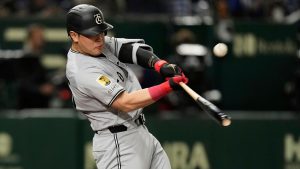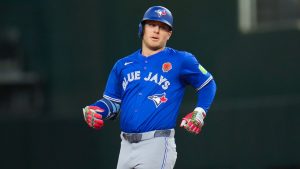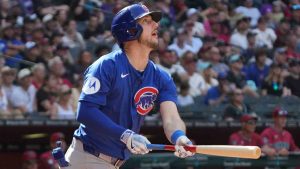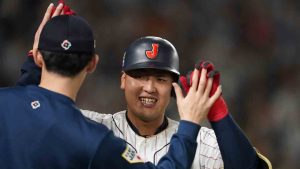DUNEDIN, Fla. — So, let’s get one thing straight — it’s GAB-ree-elle, not GABE-ree-ill.
As in Gabriel Moreno, the 22-year-old Toronto Blue Jays top prospect — one of the top prospects in the game, period. A 2016 international signee the club discovered in Barquisimeto, Venezuela and inked for a $25,000 bonus at the age of 16. A name you’re probably going to be hearing a lot this season. And a lot for seasons to come.
An athletic shortstop-turned-catcher with a plus arm and sub-two second pop times whose innate hand-eye coordination and quick, compact swing allowed him to post an OPS of 1.060 across three minor-league levels in 2021, blending both contact and power into an advanced, all-fields offensive approach. An absolute firecracker who’s made rapid progress year-over-year since turning professional, forcing his way to triple-A before his 22nd birthday, tearing up the Arizona Fall League last November, and positioning himself for an MLB debut as soon as this summer.
An uncommon talent who, if you ask those who know him best, would likely hold his own at the game’s highest level today.
“He’s ready for the big leagues,” says Max Castillo, Moreno’s teammate last season with the double-A New Hampshire Fisher Cats. “He’s a big-league hitter. He’s unbelievable.”
Well, sure, nothing wrong with a concise statement like that. But what does Moreno do well in particular?
“Everything, everything. He’s very, very good,” Castillo continues. “He’s just a very good hitter. He’s a big-league hitter, you know? You see him and you say, ‘That’s a big-league hitter.’”
Right, OK — big-league hitter. But there’s got to be something more specific, something you’ve seen Moreno do in a game or during batting practice that stands out.
“Watching him take batting practice every day, it’s funny,” Castillo says, shaking his head. “A lot of homers. So many homers. I don’t think he’s trying to hit homers. I think he’s just trying to hit the ball to the opposite side. But they’re homers. He’s very good. Like I said, he’s a big-league hitter. That’s it.”
And maybe it’s all that needs to be said. A fellow Venezuelan, Castillo knows Moreno better than most. They were roommates in New Hampshire last season and shared hotel rooms on the road. Moreno was behind the plate for seven of Castillo’s first nine outings before a pitch broke the young catcher’s left thumb, sidelining him for six weeks. They played winterball together each of the last two off-seasons for Cardenales de Lara back home in Barquisimeto.
They stayed up late after games talking about baseball, about life. They laughed at all the attention Moreno was getting as one of the game’s top prospects; how his social media DMs filled up with messages from fans asking for autographs; the way he was starting to get recognized in malls and at restaurants wherever he went.
Those Cardenales teams were littered with veteran Venezuelan big-leaguers such as Alberto Callaspo, Jose Tabata, Gorkys Hernandez, and Ildemaro Vargas. Castillo watched Moreno, one of the league’s youngest players, hang with all of them. Two years ago, at 20, Moreno slashed .373/.471/.509 over 18 games. This past winter, still rusty after spending his summer on the injured list, he posted a .758 OPS and walked as many times as he struck out.
“There are a lot of experienced guys on that team and he fits right in,” Castillo says. “It’s like here (at Blue Jays spring training.) A lot of big-league guys, a lot of experience. And he just looks the same. He’s relaxed, normal. Like a big-league guy.”

Chavez Young agrees. The 24-year-old Blue Jays outfield prospect got to know Moreno during prior spring trainings, and finally played on the same team with him last year in New Hampshire. He saw the shy, mild-mannered teenager of a few years ago grow into the outgoing, fun-loving teammate catching his outfield assists in 2021.
“We all know he’s talented — we already know he’s going to be a great baseball player. But what I don't think people understand is he's an awesome human being,” Young says. “It's just awesome to be around. He's a good clubhouse guy, great teammate, respectful. And he's always smiling. For such a great player like him, he has awesome makeup. And you just want him to be great because of what type of human being he is.”
Young’s calling card as a prospect is a huge outfield arm, one that Baseball America ranks as the best in Toronto’s system. He’s had to work to rein that power in over the years, focusing on keeping the ball down and giving his infielders secondary options to cut a throw off and nab a trailing runner trying to advance an extra base if the out at home plate isn’t there.
But Young’s also learned that having an athlete like Moreno behind the dish gives him a little more leeway to let loose.
“I just need to put it in the vicinity — anywhere close to the plate and he’s going to do the rest for me,” Young says. “There was one against the Red Sox. I was in right field, and a guy tried to tag up on me. And I was thinking, ‘It’s Moreno — just throw it anywhere close.’ Ball ended up in the dirt. But, sure enough, Moreno made a nice pick and tagged the guy out for me.”
Moreno’s growth as a defender has taken time, of course, and is the primary factor holding him back from being a big-leaguer today. Catcher is the toughest position at which to transition to the majors and, having grown up on the infield, Moreno has limited experience playing it, with fewer than 1,200 innings behind the plate since turning professional at 17.
For the sake of context — Danny Jansen, who will start at catcher for the Blue Jays on opening day, caught over 2,700 minor-league innings before making his big-league debut at 23. Even Castillo, who’s adamant Moreno could succeed in the majors today, allows that there’s work to be done when it comes to strategizing, game-calling, and on-the-fly adjustments.
“He’s gotten better every season. But I think he has to learn a little bit more,” Castillo says. “He has very good hands. He’s a very good catcher behind the plate. He’s helped me a lot when he’s caught me. He just has to talk more with the big-league catchers and get a better idea of when they’re going to call certain pitches and everything. That’s all he needs.”
Still, a constant in Moreno’s breakneck rise through Toronto’s system has been rapid, annual improvements. The Blue Jays wouldn’t have pushed him up to triple-A at the end of the 2021 season, where he was bound to be catching veterans with big-league experience, if they didn’t think he was ready for it.
Casey Lawrence was one of those veterans. He’d heard plenty about Moreno and the prospect hype around him — he’s a baseball fan, too, after all — but he’d never met him until the young catcher joined the Buffalo Bisons late last September. That’s when Lawrence learned Moreno would be catching his final start of the season.
It wasn’t an easy assignment. Lawrence doesn’t exactly bring the heat, but he does throw a kitchen sink of pitches, sinking, cutting, and running his fastball, flipping up a couple of breaking ball variations, and fading a changeup. And he has a very clear idea of how he wants his many offerings to play off one another.
“It's tough when you're throwing to anybody for the first time,” Lawrence says. “But for me, throwing six, seven pitches, it's a little bit tougher.”
Yet, Lawrence came away impressed with how simplified Moreno’s approach to preparation was. The then 21-year-old wanted to know how Lawrence liked to sequence; the different locations he preferred to use against lefties vs. righties; the lanes he wanted his catcher to set up in behind the plate. And Moreno, whose English has improved considerably in recent years, kept the conversation going between innings as the outing wore on, seeking to make tweaks and adjustments based on the in-game feedback the duo was receiving.
“It was seamless,” Lawrence says. “The guy was very prepared. The way player development is now compared to years ago, it's definitely become way more advanced than what it was. Some of these younger players like him, when they're progressing through the minor leagues, are a lot more advanced than what they would have been before.”
Lawrence went five innings that day — allowing three runs on four hits and three walks while striking out four — and picked up his seventh win of the season. Of course, it was only one outing. Lawrence isn’t professing to know Moreno’s game inside and out. But after facing 21 batters together, Lawrence came away impressed with how mature and instinctual Moreno was behind the dish — particularly in game-calling.
“He did a nice job back there reading swings,” Lawrence says. “Normally, when you don't have a relationship with somebody where they've caught you a lot, there's a lot of shaking off that has to happen to get to the right pitch. For me, it’s always fastball-changeup sequencing. But to see him being able to read swings, where maybe a guy’s a little bit ahead of the fastball, and then go right to the changeup the next pitch, was big. I didn’t have to shake to get to it.”
Playing for the first time in three months, against the highest calibre of pitching he’s ever faced, Moreno didn’t flash much of his offensive potential during that brief, three-game triple-A taste. He reached base only twice — on a single and hit by pitch — over 10 plate appearances. But he still left an impression on Lawrence with the way he prepared before each game.
“The thing that I took away the most was his mature batting practice,” Lawrence says. “A lot of times when you get a younger guy that progresses through the levels, the first thing they want to do is get in there and show you how far they can hit it. For him to just be mature throughout batting practice, work his progression the way it should be done — I think that says a lot about him.”
There’s no shortage of players who have shared clubhouses with Moreno who will say a lot about him. No shortage of scouts and evaluators throughout the game, too, who’ve watched him progress through his young career and believe his eventual destination is as an impactful MLB regular. And maybe even better.
It’s evident that Moreno’s uncommonly talented. If he played a more straightforward defensive position, his bat might be too good to keep out of the majors today. Even still, it likely won’t be long. And when he gets there, just remember — it’s Gabby, not Gabe.
“Yeah, Gabby. We all call him Gabby,” Young says. “And then he calls me ‘Chavvy.’ We go back and forth. He’ll always come up to me smiling. “Chavvy, que? Chavvy, que?” He’s got these funny mannerisms. He’s just a great teammate. We know he’s a great ballplayer. That’s expected. But when you watch him walk around the clubhouse, even outside in public, he’s really humble. He's even keeled. He's never up and he's never down. He always has that big smile on his face. And that's just joyful to watch.”






